How to choose a coffee machine?
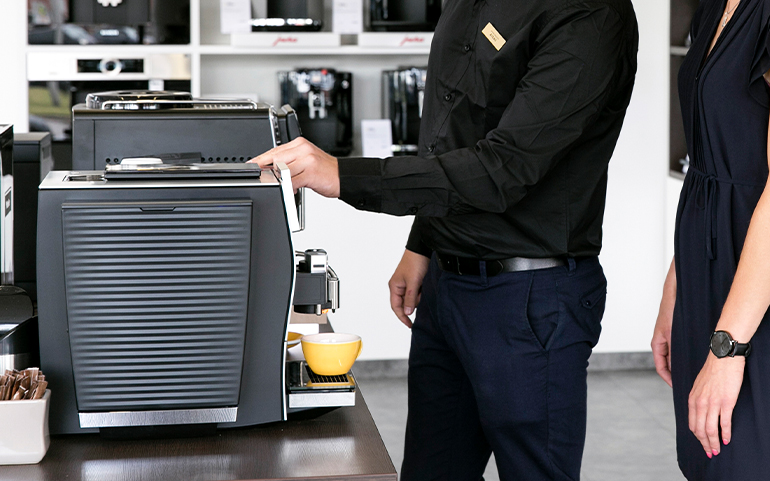
When everything around us is changing so fast, making it seemingly impossible to catch up with the world, we can only latch on to things that are timeless and already well-known to us. One of these things is undoubtedly coffee. Indeed, while the drink remains the same, the technologies involved in its preparation and presentation are constantly evolving. Not so long ago, the hosts of the homes we were visiting would usually treat us to ordinary pour-over coffee. Even though drinks prepared using this method are not inferior in any way, people soon grew tired of sifting coffee grounds through their teeth. They began trying out various means of preparing coffee differently. The first coffee makers to become popular all over the world were French presses, equipped with spring plungers. Later on, as we visited cafés more and more often, we started looking for ways to mimic the classic Italian espresso as closely as possible in our home-brewed drinks. In the process of searching for the perfect coffee, moka pots became an essential component of the coffee ritual of many people around the globe. At long last, coffee machines entered the arena of hundreds of home-brewing tools. As they became affordable to the general public, coffee machines soon turned from a luxury item to a household necessity. And so the question of how to choose the right coffee machine, as well as which criteria should enter into the equation, grew more and more pertinent — until it evolved into a real headache for thousands of us. In order to save you some time spent ruminating over this dilemma, we, Coffee Friends, will answer this question as fully as possible.
Before embarking on the task of choosing the right coffee machine, you must answer this question: do you enjoy pour-over coffee the most and simply want to get rid of grounds in your drink, or are you a coffee enthusiast, searching for the true, illustrious espresso that has been the subject of legends the world over?
If you’re a coffee lover of the first type, pour-over filter coffee machines, which don’t use pressure in the preparation process, will suit you best. Coffee prepared in these machines is usually more watery (the proportion of dissolved coffee particles found in drinks of this kind amounts to 2% — in comparison, a cup of espresso can yield up to 11% of solubles), yet the taste of the coffee beans can be experienced with more ease. Filter coffee is characterised by a so-called ‘buttery’, or silky, body, as well as a clean cup. While the amount of caffeine found in filter coffee is usually larger than that detected in espresso, the lovers of the latter kind tend to avoid filter coffee — its body is considered to be too light.
Machines using pressure to extract coffee are geared towards the lovers of espresso. Coffee prepared in such a way is full-bodied, its tastes are more concentrated, while the aftertaste is far stronger than that produced by filter coffee. Such coffee is characterised by stiff espresso foam, thick, syrupy texture, and a slightly cloudy cup that is an essential component of any espresso drink (this is due to the 11% of dissolved coffee particles that we’ve mentioned earlier).
On the market, there are several types of coffee machines which differ in the method of preparation, and thus—the price. The easiest way would be to introduce these types of appliances, their advantages and disadvantages, so that you can make up your mind and choose something that fits your personal needs.
The following scheme shows the types of coffee machines:
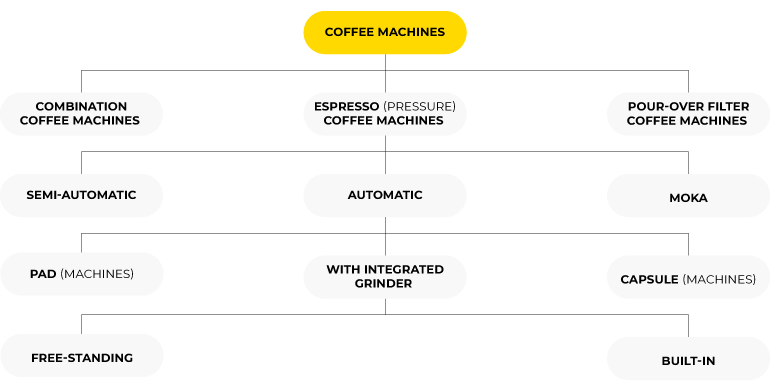
Pour-over filter coffee machines
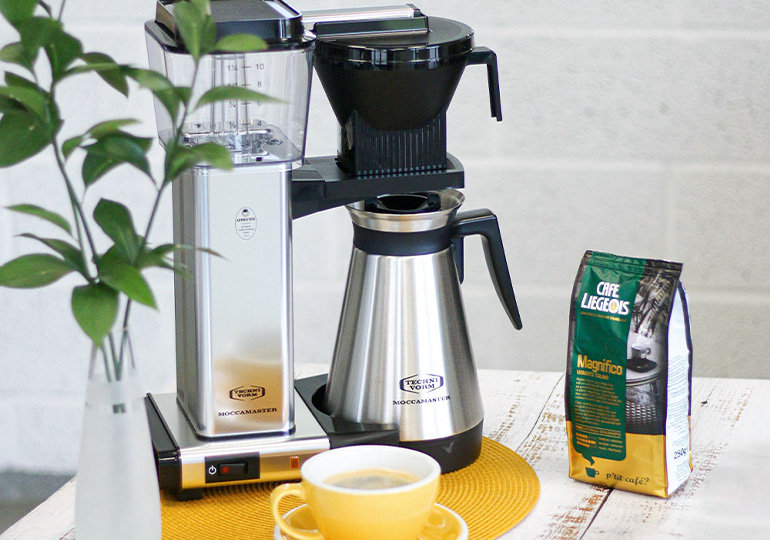
The main features and components of filter coffee machines are these:
- Water tank capacity: from 0.3 to 2 l
- Coffee container
- Filter: disposable paper filters are commonly used, yet a reusable metal filter can also be integrated. It must be washed thoroughly after each use
- Jug: it’s usually made from heat-resistant glass or, alternatively, steel. In such a case, the jug can also be used as a thermos
- Hotplate: it keeps the jug warm and maintains the temperature of your coffee for as long as 4 hours
What should you know when using these machines?
First of all, you must discover the right coarseness of ground coffee. Conventionally, it’s a tad coarser than the one used for pour-over coffee. Also, if your filter machine allows you to adjust water temperature, set it to 90–94°C. Once you’ve found coffee that is characterised by the right coarseness and have set your water to the right temperature, these machines are extremely easy to use. Just put coffee into the machine — it will pour water over the grounds all by itself and prepare the drink, drop by drop, in a fairly short time. By the way, while this is by no means set in stone, the tastiest coffee to make in a filter machine is usually of a light or medium roast.
Advantages of filter machines:
- Low price. The majority of people will find home filter machines, as well as their filters, easy to afford
- You can make more coffee in one go. This is particularly useful when drinking numerous cups one after the other or entertaining a large group of friends
- Hotplate. It will allow you to maintain the temperature of your coffee for up to 4 hours. This means that you can make coffee first thing in the morning, pour some of it from the jug once in a while right until lunchtime, and get rid of the need to prepare it all over again each time you want to enjoy a cup
- Filter machines can be used to make tea and other herbal infusions, as well as coffee
Disadvantages of filter machines:
- As we’ve mentioned earlier, such machines require coffee that has been ground to the right coarseness, so in order to prepare it properly, you’ll need a coffee grinder too
- Depending on the machine, coffee preparation can take anywhere from 10 to 15 minutes — when compared to other kinds of machines, this stretch of time seems really long. On the other hand, given the fact that you can enjoy your coffee for up to 4 hours and prepare numerous cups at once, the length of preparation can be excused
- Such machines won’t allow you to prepare milk-based drinks
- Only the more costly machines will let you adjust the strength of your coffee. We’ll tell you a secret though: you can adjust the strength of your coffee without using the machine if you change the coarseness of ground coffee. If you want your coffee to be stronger, grind it more finely, but if you like it lighter, make the grounds coarser
- Filter coffee contains a lot of caffeine. If you don’t tolerate caffeine that well, yet enjoy filter coffee, you should drink more water during the day. This will reduce the concentration of caffeine in your blood
- The characteristics of filter coffee are not suited for the lovers of espresso
The most well-known manufacturers of filter coffee machines:
- Philips
- De‘Longhi
- Melitta
- Moccamaster
- Bosch
- Siemens
You can choose a filter coffee machine here.
Moka pots
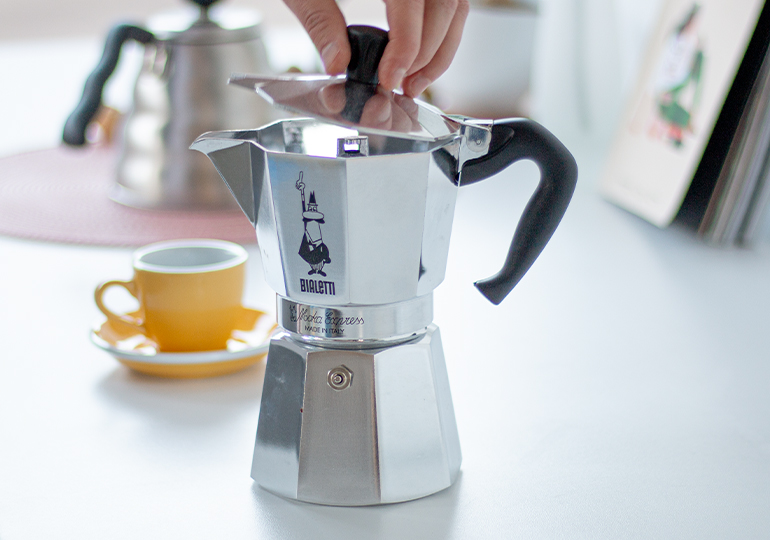
The main features and components of moka pots are these:
- Jug at the top
- Strainer in the middle with two metal filters at the top and bottom
- Water tank at the bottom
- Capacity: 3–12 cups
Even though this coffee maker isn’t equipped with a pressure pump, it’s included amongst coffee preparation methods that use pressure to prepare drinks. Steam, which is trapped in the pot, creates pressure that forces water up through the coffee grounds. Afterwards, coffee extracted in this way is poured through the holes located in the top chamber.
Coffee brewed in a moka pot is strong and heavy-bodied. Although pressure created by the pot isn’t high enough to prepare true espresso (it needs to be at least 9 bar), coffee brewed with the help of this method will bring you closest to it. By the way, if you brew coffee in a moka pot using coffee beans that have an intense flavour or are finely ground, we recommend diluting the drink with water. It’s worth emphasising that the principles of this coffee preparation method allow you to add warm water to the prepared coffee. In this way, you’ll not only temper over-extracted coffee, but will also add sweetness to the drink (this applies to all brewing methods).
Moka pots can be both standard and electric. Standard moka pots are put on gas and induction stoves, while electric ones are equipped with a timer and a thermometer.
When using this coffee brewing method, nothing is as important as taking the pot off the heat as soon as the drink starts flowing through the holes in the top chamber. This prevents coffee from boiling and, consequently, losing all of its flavour.
Advantages of Moka pots:
- Good value for money
- Once you learn how to use it, you’ll be in complete control of the preparation process and the end results
- Easy to maintain
- No need for special maintenance tools
Disadvantages of Moka pots:
- Long brewing time (up to 15 minutes)
- The pot must be constantly monitored
- In order to adjust the strength of your coffee, you’ll need to use a coffee grinder
- Since true espresso cannot be prepared in a moka pot, coffee brewed with the help of this method may be too weak for the lovers of espresso and too strong for the fans of filtered coffee
The most well-known manufacturer of moka pots:
- Bialetti
You can choose a moka coffee pot here.
Semi–automatic coffee machines
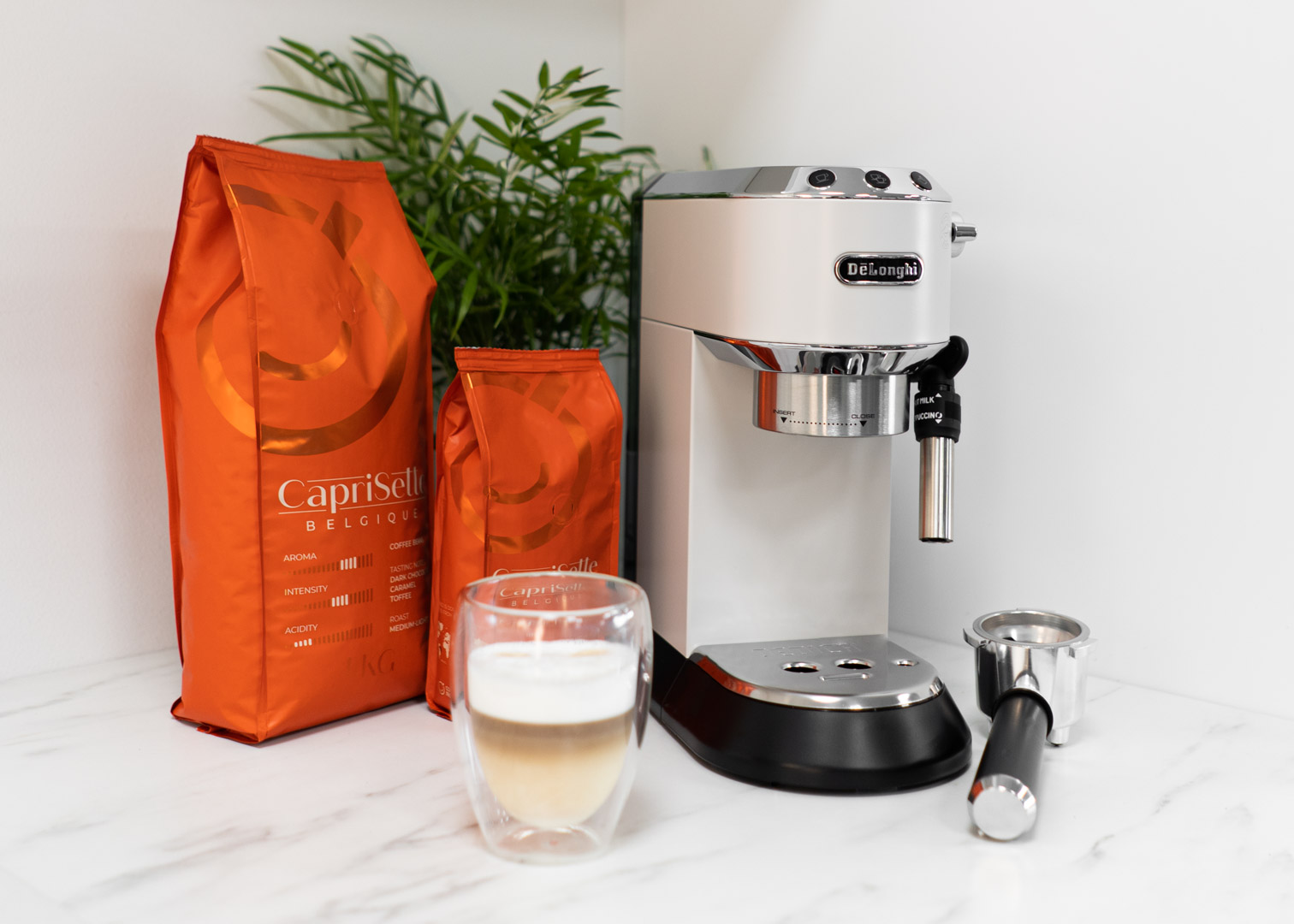
The main features and components of semi-automatic coffee machines are these:
- Semi-automatic coffee machines meant for home use usually have one brew group, whereas café models can have up to three
- Barometer: some machines have one barometer that indicates pressure reached during coffee preparation (it should be around 9 bar), while other machines have a second barometer that shows boiler pressure as well. When the barometer reaches 1.1 bar, this indicates that the machine has already warmed up and can be used to make coffee
- Thermometer: if your coffee machine allows you to adjust water temperature, set it to 90–94°C. Luxury coffee machines enable you to change steam temperature as well — this means that you can adjust the strength used to blow steam through the steam wand
- Portafilter: ground coffee is put into it
- Steam wand (cappuccinatore): it’s used to froth milk
- Tamper: it’s used to press coffee that has been put into the portafilter
- Milk pitcher
What should you know when using these machines?
Semi-automatic coffee machines are usually found in cafés and bars. With the help of such coffee machines, you can prepare true espresso. Brewing coffee in this way requires knowledge and skills, but once you get the hang of it, you’ll be able to tailor your drinks to your individual taste. The main difference between this type of appliance and a fully automatic coffee machine lies in the fact that you must put ground coffee into the portafilter yourself. For the perfect results, use freshly ground coffee, but if you‘re not an expert, pre-ground coffee will work just as well. Some home coffee machines offer the possibility of preparing coffee from special coffee capsules. Semi-automatic coffee machines can also be used to froth milk with the help of a special steam wand that is built into them, but this again requires some skill. For this reason, we recommend these coffee machines to people who want to be fully involved in the preparation process and be responsible for every detail of their favourite coffee. Obviously, in order to obtain satisfactory results, you shouldn’t buy the cheapest machine available. Steam wands of domestic coffee machines are usually not as powerful as the ones included in more expensive machines or those that are used in bars. Even if you have the necessary skills, the cheapest option may not be powerful enough for you to put them to use. It’s best to start off with Lelit coffee machines: their prices are affordable and the machines themselves are powerful enough to brew all of your favourite drinks. For even greater precision and luxury, consider manufacturers such as Rocket Espresso or Nuova Simonelli. Finally, if you drink black coffee most of the time and the milk frothing option isn’t relevant to you, entry-level machines, like those manufactured by De’Longhi and Sage, will do the trick.
Advantages of semi-automatic coffee machines:
- They’re very precise and allow you to control the coffee brewing process from start to finish
- You can enjoy just about any drink, exactly like you would in a café (if you have the skills and knowledge)
- Extremely high-quality results (if you have the skills and knowledge)
- Affordable price if you buy a semi-automatic coffee machine meant for home use
Disadvantages of semi-automatic coffee machines:
- Knowledge and skills are required
- The coffee preparation process takes time
- When entertaining guests, it takes longer to serve each of them a cup of coffee, as there’s a lot of manual work involved in coffee preparation
- Quite a lot of maintenance is needed (especially daily one, like cleaning the portafilter and steam wand, as well as rinsing the milk pitcher)
The most well-known manufacturers of semi-automatic coffee machines:
- De‘Longhi
- Sage
- Lelit
- Rocket Espresso
- Nuova Simonelli
You can choose a semi-automatic coffee machine here.
Combination coffee machines
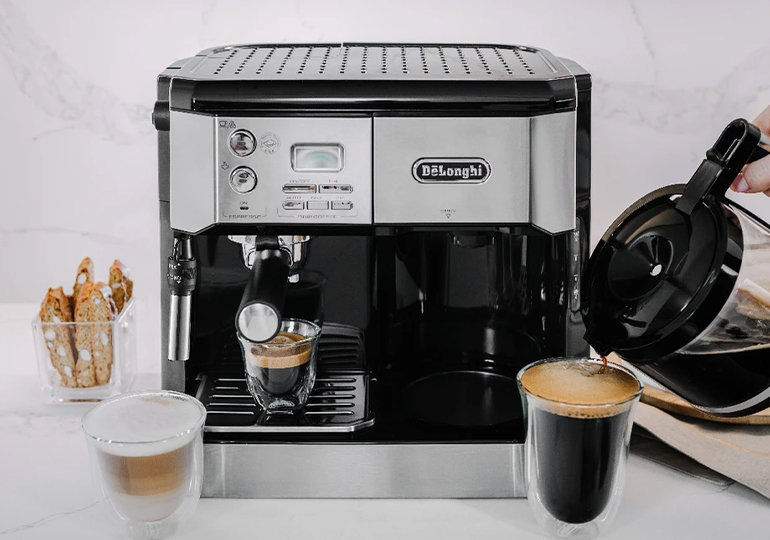
We have great news for those who have already come to terms with the idea that they’ll need two coffee machines for the simple reason that they themselves love espresso, while their significant other enjoys filter coffee. One of the most spectacular aspects of the 21st century is the fact that the same solution can now work for people who have different tastes. In this case, the solution is a combination coffee machine, which can prepare both espresso and filter coffee.
Depending on the model of a coffee machine, its components and features may differ:
- Timer: it allows you to set the time for when you want to start brewing coffee. This function will come in handy if you want to enjoy a cup of coffee as soon as you wake up
- Automatic dispensing of coffee and water
- Possibility of adjusting coffee strength
- Automatic rinsing function: this function automatically rinses the system, but it’s worth pointing out that you’ll have to perform all of the other cleaning procedures (descaling, washing the system with the help of a solvent) yourself
- Steam wand: once you’ve perfected your skills, you’ll be able to prepare cappuccino or latte and even experiment with latte art
- Water filter, which protects the machine from limescale and softens the drink
- LCD display: you can monitor the coffee preparation process and easily change settings
Advantages of combination coffee machines:
- Possibility of preparing both espresso and filter coffee
- Easy maintenance
- Most steps involved in coffee preparation are automated
- Good price
Disadvantages of combination coffee machines:
- The steam wand (cappuccinatore) isn’t very powerful
- They’re not as precise as coffee machines that prepare espresso or filter coffee only
- A separate coffee grinder is needed
The most well-known manufacturer of combination coffee machines:
- De‘Longhi
Capsule coffee machines
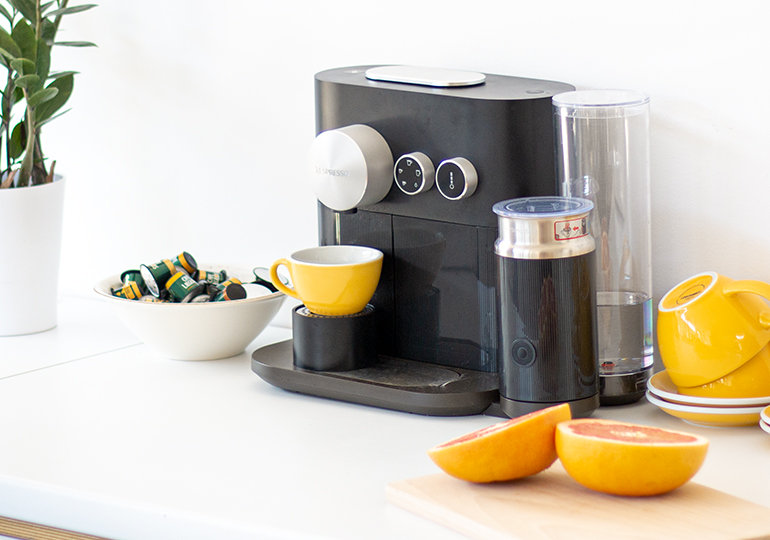
The main features and components of capsule coffee machines are these:
- Capsules: the two most popular capsule systems were created by Dolce Gusto and Nespresso
- Pump: when buying a capsule coffee machine, pay attention to pump capacity
- Water tank: its capacity can vary from 0.5 to 1 l. Before buying a machine, ask yourself how large the water tank should be to satisfy your needs (choose based on the number of cups you drink daily). Also, consider the amount of space you have for the machine — the larger the water tank capacity, the more space the machine will take up
- Design: due to the growing popularity of capsule coffee machines, more and more different designs are available, so you can find an option that suits any home style
What should you know when buying a capsule coffee machine?
Capsule coffee machines are currently going through a period of extreme popularity. More and more people are choosing this coffee preparation method for their homes based on good value for money and the variety of coffee drinks produced. When talking about these appliances, two different systems and technologies of both coffee capsules and the machines themselves should be mentioned: these are Dolce Gusto and Nespresso. The first option is cheaper in terms of equipment, both ground coffee and instant coffee is used in the capsules, and there are separate milk powder capsules for your milk-based beverages. Dolce Gusto machines are a real delight, as they offer an extremely wide variety of coffee drinks with additional flavours. On the other hand, machines using the Nespresso technology are a bit more expensive, only ground coffee is used in their capsules, and appliances that are able to prepare milk-based beverages use real milk for this purpose. These machines also use higher pressure, which reaches 19 bar (Dolce Gusto machines use pressure of 15 bar), so espresso coffee prepared with the help of such appliances is of extremely high quality. In addition, Nespresso boasts an extremely wide variety of espresso and black coffee capsules.
| Dolce Gusto | Nespresso |
| Cheaper coffee machines | More expensive coffee machines |
| Pressure of 15 bar | Pressure of 19 bar |
| In the capsules: instant and ground coffee | In the capsules: ground coffee |
| Milk-based drinks are made from milk powder | Milk-based drinks are made from real milk |
| A wide range of coffee drinks with various additional flavours | A wide range of espresso and black coffee drinks |
Advantages of capsule coffee machines:
- Low price
- Possibility of preparing true espresso (sufficient pressure is used)
- Each family member can enjoy coffee from a different type of capsule
- Compactness
- Easy maintenance
Disadvantages of capsule coffee machines:
- Although coffee is stored in a sealed capsule, it’s ground in advance, which causes it to lose its flavour faster
- Increased use of plastic
- Once you’ve chosen a capsule system, you can only use capsules designed for it
- The range of capsules, although wide, is still narrower than that of ground coffee or beans
The most well-known manufacturers of capsule coffee machines:
- De‘Longhi
- Nespresso
- Krups
You can choose a capsule coffee machine here.
Pad coffee machines
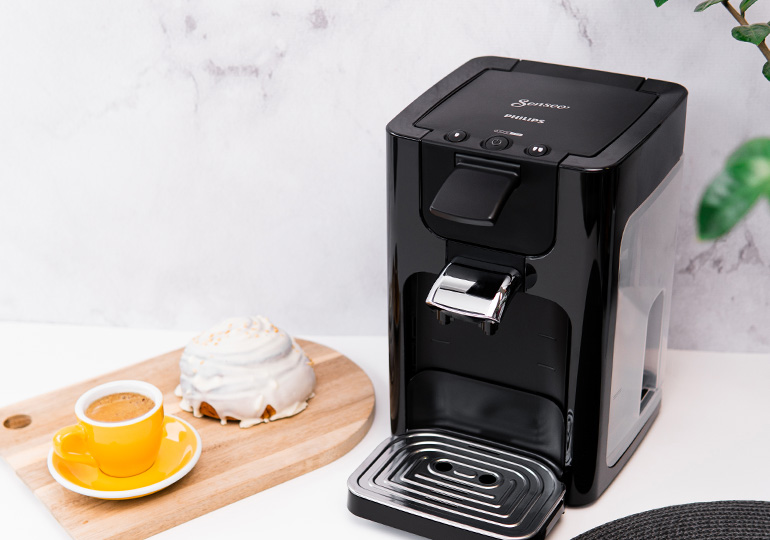
The main features and components of pad coffee machines are these:
- Special coffee pads, which are used in them
- Screen, which allows you to follow the preparation process and adjust coffee strength
- Some models (for example, Saeco Senseo Latte Duo HD7855) are equipped with an automatic milk frothing system
What should you know when buying a pad coffee machine?
These machines are a cheaper alternative to capsule coffee machines. Thanks to rapidly evolving technologies, we can now state with confidence that pad coffee machines are on a par with the capsule ones (even though they used to prepare coffee that was quite weak just a few years ago). The consistency of coffee prepared with them is very close to espresso, while the automatic milk frothing system, which is integrated in some machines, raises them above all standards of price and quality. However, the main disadvantage of pad coffee machines remains the same as that of capsule ones — coffee stored in the pads expires much faster. The best solution in this case is choosing a popular manufacturer whose pads tend to stay in the warehouse for a very short time, so the stock is constantly replaced with a new batch.
Pad coffee machines, just like the capsule ones, should be purchased by people who don’t have much space in their kitchen. This coffee machine is also suited to those who don’t want to spend a lot of money on coffee each month. Pads cost less than capsules, while the maintenance of such a machine doesn’t require a great deal of supplies.
Advantages of pad coffee machines:
- Affordable price
- Cheap pads
- Thanks to advanced technologies, coffee prepared in these machines closely resembles espresso
- Possibility of adjusting coffee strength
- Each family member can enjoy coffee from a different type of pad
Disadvantages of pad coffee machines:
- Coffee expires faster
- The quality of coffee is still a bit lower compared to the drinks prepared by capsule machines
- Compared to capsule coffee machines, the range of available coffee drinks is narrower
The most well-known manufacturers of pad coffee machines:
- Philips
- Handpresso: these machines are mobile, which means that you’ll be able to prepare coffee while out in nature, during camping trips or even in your car!
You can choose a pad coffee machine here.
Bean-to-cup coffee machines
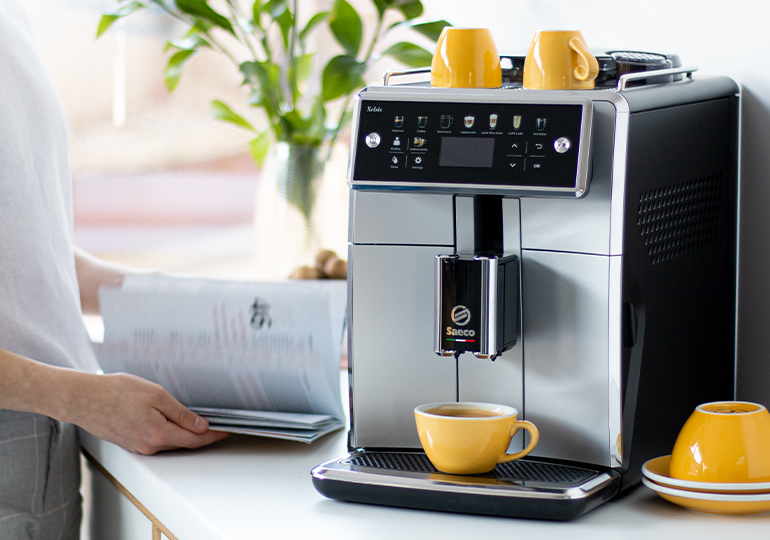
The main features and components of bean-to-cup coffee machines are these:
- Grinder: made from ceramic or steel
- Water tank and water filter
- Heating element: as with other machines, if possible, set water temperature to 90–94°C
- Pump: 15 or 19 bar
- Possibility of choosing between numerous coffee recipes
- Possibility of creating and saving personal recipes (user profiles)
- Automatic rinsing
- Drip tray: it’s usually equipped with sensors that let you know when the tray is full and needs to be emptied. We recommend emptying the tray every evening, even if you’re not prompted to do so by the machine before heading off to bed. Also, if you’ve taken out the tray, make sure to throw used coffee grounds out as well — otherwise, the machine will think that you’ve done that and will start counting the number of prepared coffee portions from zero all over again
- Some models are equipped with an integrated automatic milk frother or steam wand (cappuccinatore) used for frothing milk manually
- Screen that allows you to easily change settings and track the coffee preparation process
- Height-adjustable coffee spout
What should you know when buying a bean-to-cup coffee machine?
Since you’re buying a coffee machine because you want to drink coffee, you need to consider the integrated coffee recipes first. If you only drink black coffee, look for a machine without a milk system: this will allow you to save money spent not only on the coffee machine itself, but also on maintenance products. If you’re looking for a coffee machine designed specifically for the preparation of milk-based coffee drinks, decide whether you want to froth milk with a steam wand yourself or whether it would be more convenient for you if a machine with an integrated cappuccinatore did it all for you. In the latter case, look for a machine with a milk system that is easy to maintain. Various tanks, additional tubes and their connections make maintenance procedures much more difficult. In the opinion of Coffee Friend, another important function is the option of preparing a double portion of your favourite drink using a double dose of coffee and grinding each of the doses separately. This function will help you avoid coffee that is too weak or watery. Also, contrary to filter coffee machines, coffee of a darker roast suits bean-to-cup machines best. Due to high pressure, bean-to-cup coffee machines dispense coffee much faster, so coffee of a lighter roast may become unpleasantly acidic. On the other hand, dark-roasted coffee that has been dispensed quickly will be marked by the perfect balance of bitterness, acidity and sweetness. Once you’ve considered these key functions, you can move on to thinking about additional features: automatic rinsing, screen, design, as well as speed and noisiness.
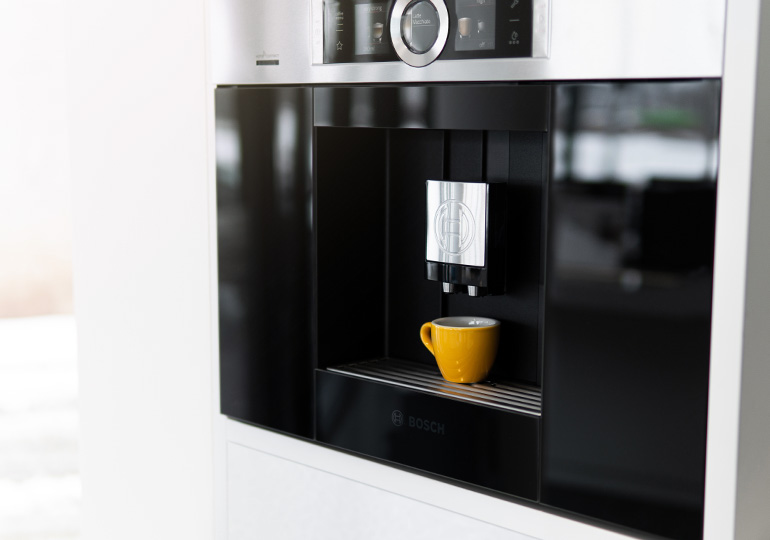
Built-in coffee machines deserve a separate mention. If you have an integrated oven, microwave or other built-in appliances in your kitchen, the option of purchasing a coffee machine of this type may also be worth considering. Such machines can be connected directly to the water supply, so you’ll forget all about the constant need to fill up the water tank. Pouring coffee beans into a built-in machine is also extremely convenient — you won’t have to worry about finding a suitable location for your coffee machine, with no potential obstructions above it. Also, amongst all of the other features, a huge advantage of these machines lies in their design. A wide selection of various appliances makes it possible to discover the right option even for the most extraordinary kitchens. In addition, it’s good to know that, having noticed the growing popularity of built-in machines, manufacturers started investing in their quality too. As a result, it now matches the quality of regular bean-to-cup machines. Unfortunately though, coffee machines of this type are often more expensive than the regular ones. Compared to the price of an ordinary bean-to-cup coffee machine with the same capacity and the same functions, the price of a built-in machine is higher.
In terms of price, bean-to-cup appliances offer what is probably the widest price range amongst all coffee machine types. This is because their price depends on numerous factors, including materials that are used to make them and the available functions. So if you have a limited budget, yet still want to enjoy good, high-quality coffee, invest in the main factors that we’ve mentioned previously, and only then consider the aspects of comfort and design.
Advantages of bean-to-cup coffee machines:
- Integrated grinder, which allows you to use freshly ground coffee
- Easy to use — no special skills required
- Coffee is prepared quickly
- Possibility of preparing coffee at the touch of a button
- Pressure that is used to make coffee (15 or 19 bar) reveals the best properties of your coffee beans
- Automatic maintenance programs
- Energy-saving mode
- Possibility of choosing a built-in machine
- Wide drink selection and possibility of saving separate recipes for each family member
- Possibility of connecting the appliance directly to the water supply
- Numerous different designs
Disadvantages of bean-to-cup coffee machines:
- Higher price
- They tend to take up quite a lot of space
- Various maintenance programs and products required
The most well-known manufacturers of bean-to-cup coffee machines:
- De‘Longhi
- Philips
- Saeco
- Siemens
- Bosch
- Krups
Now when you know what to look for when choosing a coffee machine of each category, we want to tell you briefly how to choose the category itself, as well as how to pick the perfect coffee to go along with it.
First, ask yourself what is more important to you: the beans used to make coffee or the coffee machine itself. If you’ve chosen the first option, go for a machine that suits your favourite beans best. For example, lovers of specialty, single-origin coffee will unveil the best qualities of their beans by using filter machines, while fans of strong coffee will benefit from appliances that utilise pressure.
If the machine itself is more important to you, make your choice based on your favourite drink (espresso, strong black coffee, lighter coffee, filter coffee, latte or a different milk-based beverage). Once you’ve purchased a machine, buy coffee whose flavour will be best revealed by your chosen appliance.
Once you’ve chosen both the machine and the coffee variety, don’t be afraid to experiment. The best flavours are discovered by those who search for them, and a kilogram of ruined coffee beans is often far better than tons of tasteless coffee waiting for you in the future.
We know how hard it is to choose a coffee machine, so we’re always ready to help. If you can’t find the answers in this article, you’re welcome to call us, write to us or visit our stores where our colleagues — true coffee experts — will help you find exactly what you’re looking for!
You can choose a bean-to-cup coffee machine here, and see the build-in versions here.
Sum up
Now when you know what to look for when choosing a coffee machine of each category, we want to tell you briefly how to choose the category itself, as well as how to pick the perfect coffee to go along with it.
First, ask yourself what is more important to you: the beans used to make coffee or the coffee machine itself. If you’ve chosen the first option, go for a machine that suits your favourite beans best. For example, lovers of specialty, single-origin coffee will unveil the best qualities of their beans by using filter machines, while fans of strong coffee will benefit from appliances that utilise pressure.
If the machine itself is more important to you, make your choice based on your favourite drink (espresso, strong black coffee, lighter coffee, filter coffee, latte or a different milk-based beverage). Once you’ve purchased a machine, buy coffee whose flavour will be best revealed by your chosen appliance.
Once you’ve chosen both the machine and the coffee variety, don’t be afraid to experiment. The best flavours are discovered by those who search for them, and a kilogram of ruined coffee beans is often far better than tons of tasteless coffee waiting for you in the future.
We know how hard it is to choose a coffee machine, so we’re always ready to help. If you can’t find the answers in this article, you’re welcome to call us, write to us or visit our stores where our colleagues — true coffee experts — will help you find exactly what you’re looking for!
